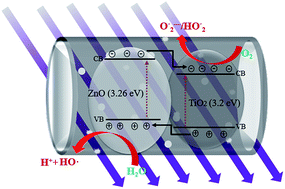Facile fabrication hybrids of TiO2@ZnO tubes with enhanced photocatalytic properties†
Abstract
Hollow nano-tubes of TiO2 and TiO2@ZnO hybrids were produced by a facile and mild approach combining an electrospinning technique and soaking method, followed by calcination. During the synthesis process, the electrospinning procedure provides the templates for the fabrication of hollow nano-tubes by producing the PS fibres, which are porous and enable the immobilization of amorphous TiO2 through the soaking method. After that, the composite fibers of TiO2/PS and TiO2@ZnO/PS were calcined into pure TiO2 and TiO2@ZnO tubes after the complete combustion of organic materials. The samples were then characterized by Scanning Electron Microscopy (SEM), Transmission Electron Microscopy (TEM) and X-ray diffraction (XRD). Ultimately, the photocatalytic performance of the hybrids was evaluated from the degradation of methylene blue (MB), where they exhibited excellent photocatalytic activity. The proposed mechanism for the enhanced photocatalytic efficiency of the samples is explained at the end of the paper. In principle, the approach to the fabrication of TiO2 tubes is demonstrated to be an effective and robust strategy to fabricate long and uniform metal-oxide micro-nano tubes on a large scale.


 Please wait while we load your content...
Please wait while we load your content...